
Winter is hard on us cold-climate gardeners. The days are short, and the nights so very long. It’s drab and dreary and gray pretty much all the time. The sunniest days are typically the most miserably cold.
We want sunshine! We want to smell the air! We want to hear the birds chirping and bees buzzing! We want and need living color!
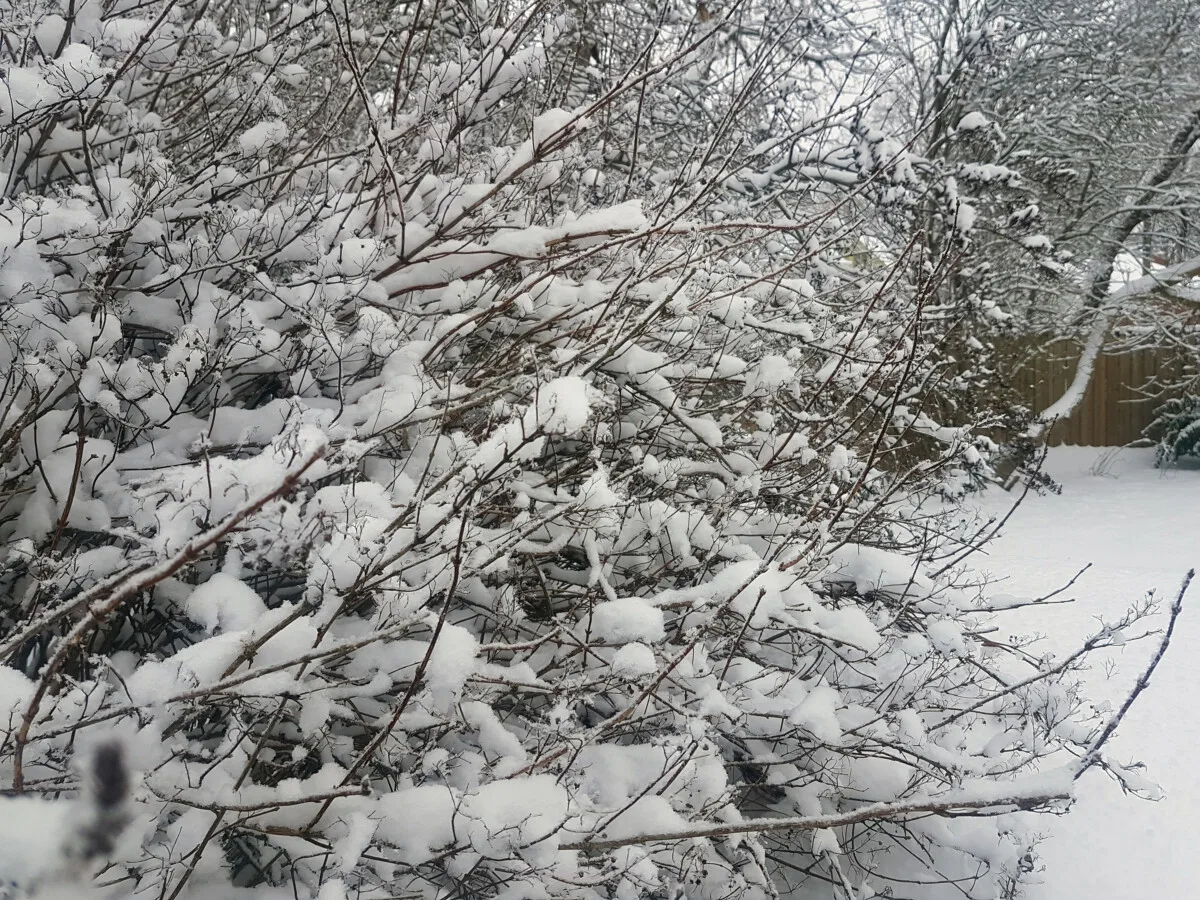
But gardening is patience, even during the off-season. Would we appreciate the first spring thaw nearly as much if we didn’t have to suffer through winter? Probably not. Or at least that’s what I tell myself.
Luckily, we have houseplants to fill the gap and help spirit us through the winter blues.
Crowding your windowsills with lovely greenery is one of the healthiest ways to cope with the dearth of life outdoors, I’d say.
What’s even better for fending off the SAD? Grab a few indoor plants that push out colorful and glorious blooms from November to March, exactly at the time we need to see them most.
Here to help keep us sane and grounded, these ten houseplants are the perfect companions to wait out the winter and remind us that spring is coming.
1. Cyclamen (Cyclamen persicum)
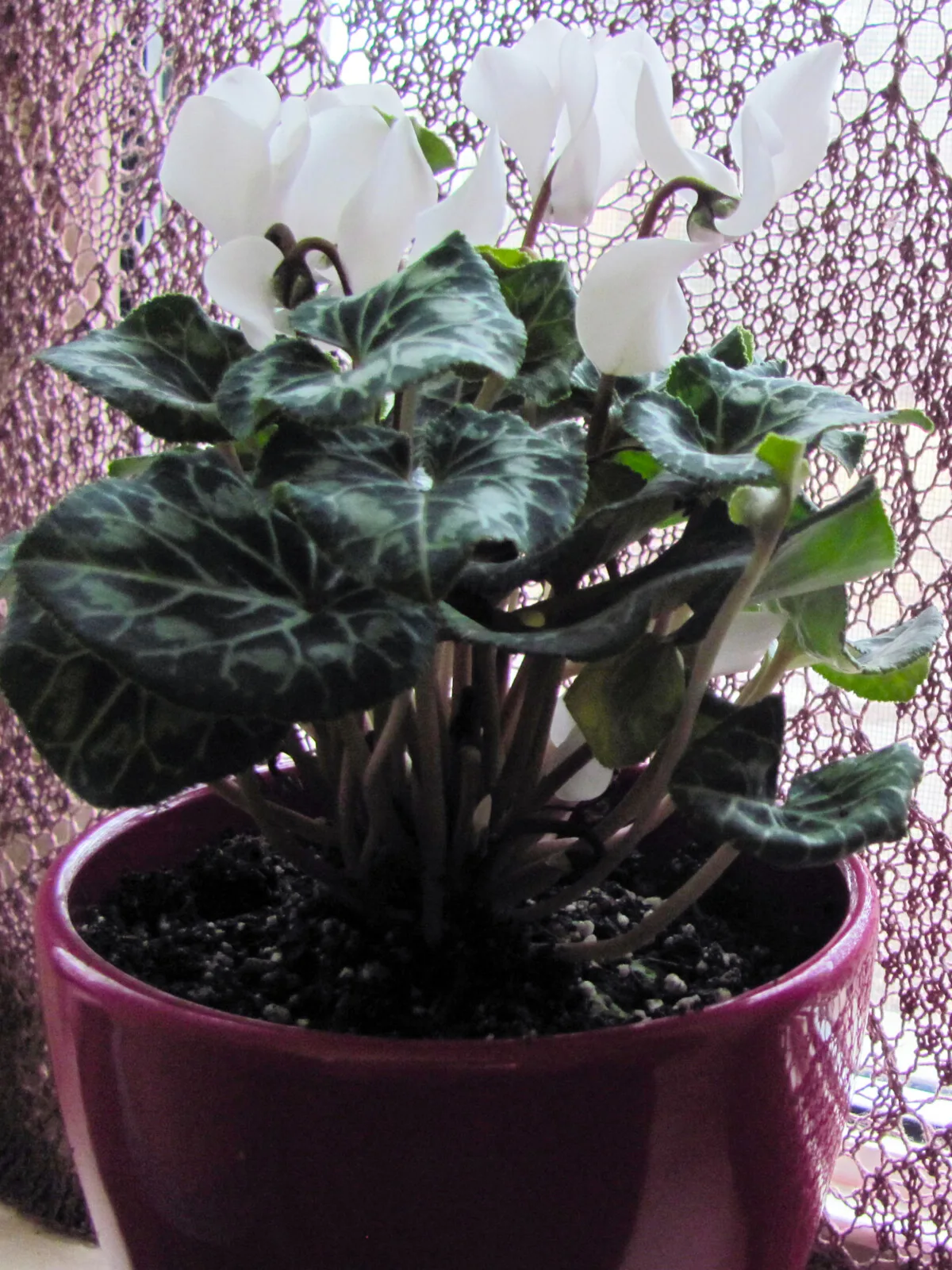
Just when most other plants are entering their winter slumber, cyclamen springs to life.
In its native range in the Mediterranean – from North Africa to West Asia to Southeastern Europe – cyclamen is found growing in open rocky slopes and in shady spots in pine and oak forests. In summer, when it’s hot and dry, cyclamen seemingly dies back entirely. But as soon as the weather turns cooler and wetter, the tubers below give rise to a spiral of fresh leaves and blooms.
It’s an intriguing plant from top to bottom.
The fleshy basal leaves are heart-shaped, rimmed in varying shades of green with flecks of silver coursing down the veins. As a foliage-only plant, cyclamen is handsome, but its flowers will steal your attention.
The twisted and reflexed petals – resembling beating wings – bloom above the foliage on leafless shoots. You can find these in hues that will warm your heart on the coldest of days – in lavender, violet, rose, magenta, red, or white. Cyclamen flowering lasts for around 3 months before plants begin their summer retreat.
- Light: Bright, indirect
- Soil: Organically rich, well-draining mix
- Bloom set: November to March
2. Holiday Cactus (Schlumbergera spp.)
From autumn all the way to spring, the blooms of the holiday cactus group – Thanksgiving, Christmas, and Easter cactus – are here to see us through.
The similar but different holiday cactus species originate from tropical and subtropical rainforests in Brazil. Despite being succulents – which often grow in arid environments –these epiphytic cacti are most pleased in high-humidity milieus.
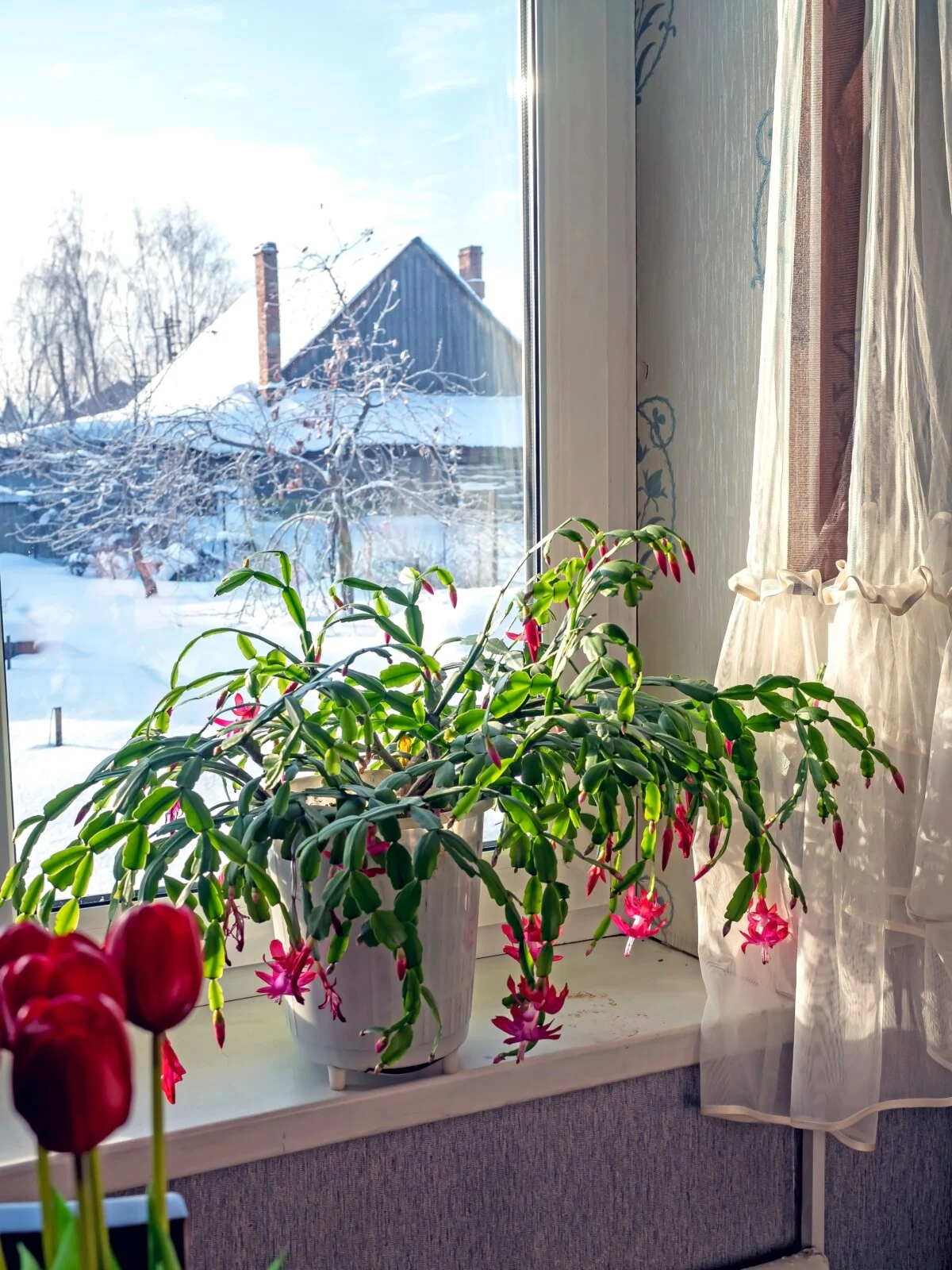
Grow all three varieties for a captivating relay of blooming times:
Thanksgiving cactus (Schlumbergera truncata) kicks things off with buds and blooms setting in from November to December. The elongated and tubular flowers come in softer shades of pink, cream, gold, and salmon but also vibrant purple, hot pink, and deep red.
If you’re lucky, she’ll give a second flowering in mid-February.
Next comes the Christmas cactus (Schlumbergera x buckleyi), its arching fleshy stems adorned with blooms beginning in November and continuing on until mid-February. The showy flowers, most commonly pink or orange or white, droop gracefully downward.
Follow it up with Easter cactus (Rhipsalidopsis gaertneri), and now we’re cooking. From February to May, Easter cactus is a generous producer of daisy-like flowers in shades ranging from white to pink to orange.
- Light: Bright, indirect
- Soil: Succulent mix
- Bloom set: November to December for Thanksgiving cactus; November to February for Christmas cactus; February to May for Easter cactus
3. Kalanchoe (Kalanchoe blossfeldiana)
Kalanchoe blesses us with an incredibly long blooming window. When the days shorten in fall, plants begin to bear dense clusters of flower buds above the dark green foliage. As these blooms open up and fade away, new umbels take form. Thanks to kalanchoe’s slow growth habit, the flowering show is continuous and finishes just as our outdoor gardens wake up.
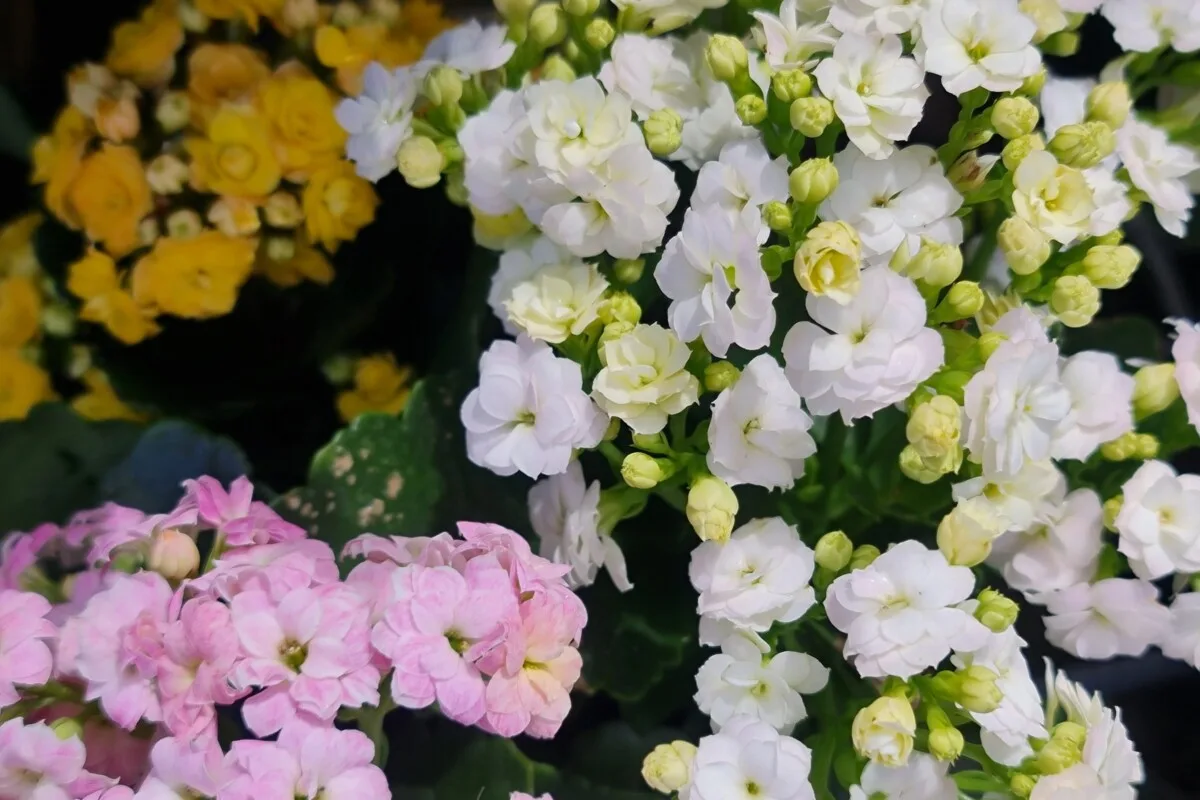
The ease of care and popularity of kalanchoe has borne many cultivars. Blooms come in single-flower, double-flower, and rose shapes in scarlet, peach, fuchsia, amber, and white.
Native to the dry mountain plateaus of Madagascar, kalanchoe is a succulent that flourishes with bright light, soil on the drier side, and low levels of humidity.
- Light: Bright direct or indirect
- Soil: Organically rich, well-draining mix
- Bloom set: November to May
4. Spring Bulbs
Most spring bulbs require a chilling period before they will dazzle us with blooms.
Outdoors, we plant them in the fall and wait for the big reveal in spring. Indoors, spring bulbs will bear their cheerful blooms at any time of year, so long as they are kept in a cool and dark place for 3 to 4 months.
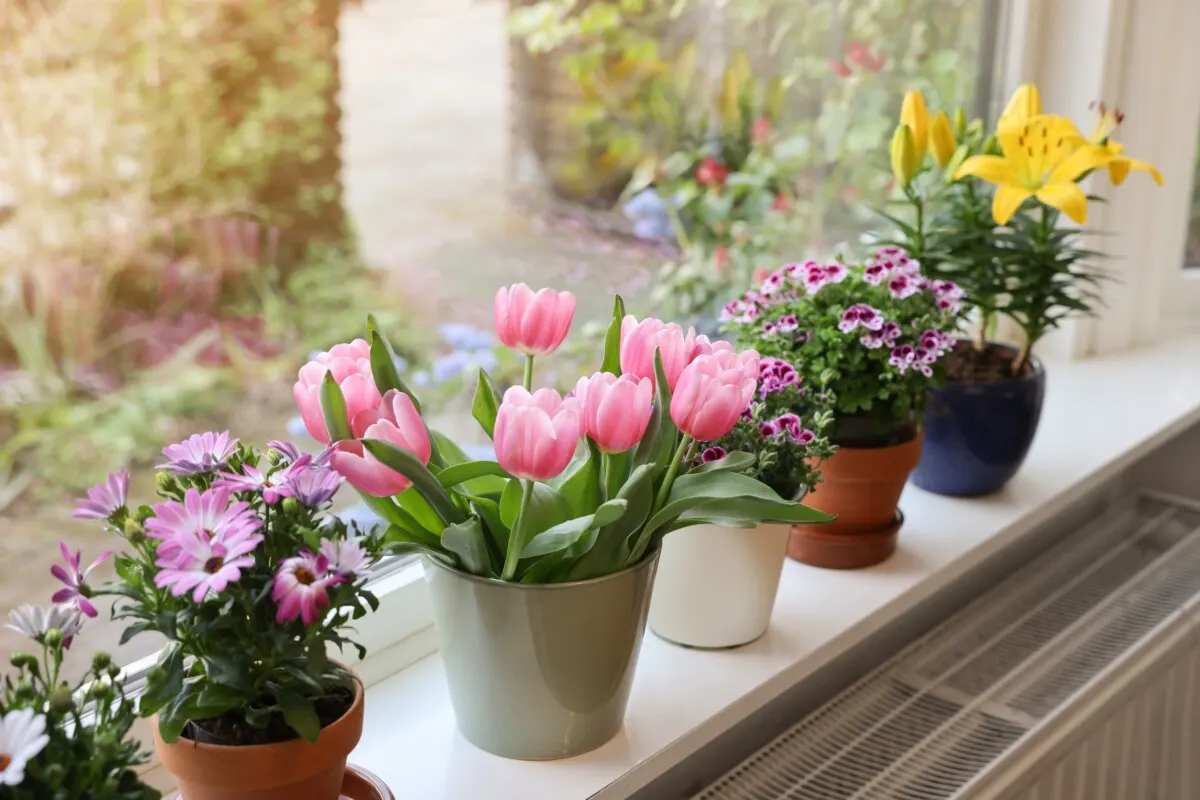
Get the timing right, and you’ll have staggered bloom times all through winter:
- Tulip (Tulipa)
- Daffodil (Narcissus)
- Paperwhite (Narcissus papyraceus)
- Hyacinth (Hyacinthus)
- Grape Hyacinth (Muscari)
- Crocus (Crocus)
- Snowdrops (Galanthus)
- Dwarf Iris (Iris reticulata)
- Siberian Squill (Scilla)
- Windflower (Anemone)
- Lily-of-the-Valley (Convallaria)
- Glory of the Snow (Chionodoxa)
With the exception of paperwhite, all spring bulbs need 12 to 16 weeks of chilly, but not freezing, temperatures between 40°F to 45°F (4°C to 7°C). Plant bulbs in an organic mix and stick pots in a cool cellar, unheated attic, cold frame, or spare refrigerator if you have it. They need complete darkness during their chilling time.
Haul them out of cold storage, and most will flower in about 4 weeks. After flowering, plant daffodil bulbs out in the garden, and they will rebloom seasonally. Most other bulbs are rarely successful when forced to rebloom again indoors or planted out – but that doesn’t mean you can’t give it a try.
- Light: Bright direct or indirect
- Soil: Organically rich, well-draining mix
- Bloom set: Spring bulbs typically flower 3-4 weeks after chilling
5. Amaryllis (Hippeastrum spp.)
There’s much to love about Amaryllis. If not for its magnificent 4 to 10-inch trumpet-shaped flowers on 1 to 2-foot tall stalks, then for its amazing suite of colors that range in red, pink, orange, and white.
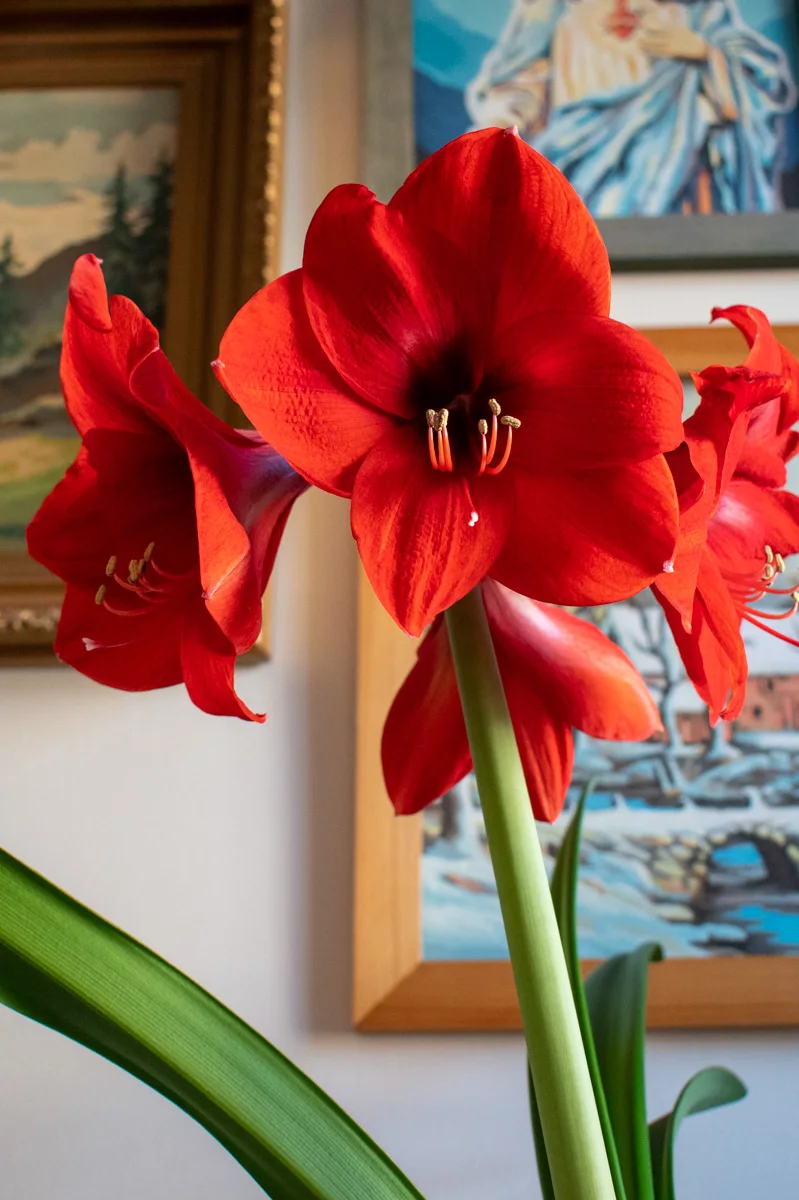
There are many varieties of amaryllis, some with single or double flowers, others with bicolor edges, stripes, and mottling. And amaryllis is a flowering bulb that you can keep and prompt to rebloom again and again.
Unlike most spring bulbs, amaryllis doesn’t require a period of dormancy to flower.
After flowers have faded, care for the plant as you normally would – give it sunlight, water, and fertilizer, and the bulb will send up more blooms in time.
To control the growing cycle and time the flowers to bloom in wintertime, you can store amaryllis bulbs in a dark, dry, and cool spot in temperatures between 50°F and 60°F (10°C and 15°C). Leave them there for 2 to 3 months, and amaryllis will reliably flower about 5 weeks later. For an uninterrupted sequence of blooms, start forcing bulbs every week or two for a beautiful view all winter long.
- Light: Morning light in an east-facing window
- Soil: Organically rich, well-draining mix
- Bloom set: 4 to 6 weeks after breaking dormancy
6. Pink Jasmine (Jasminum polyanthum)
If you really want to let loose the happy-making brain chemicals, pink jasmine proffers not only gorgeous masses of star-shaped blooms in the dead of winter – but also a delectable fragrance that easily fills up the whole room.
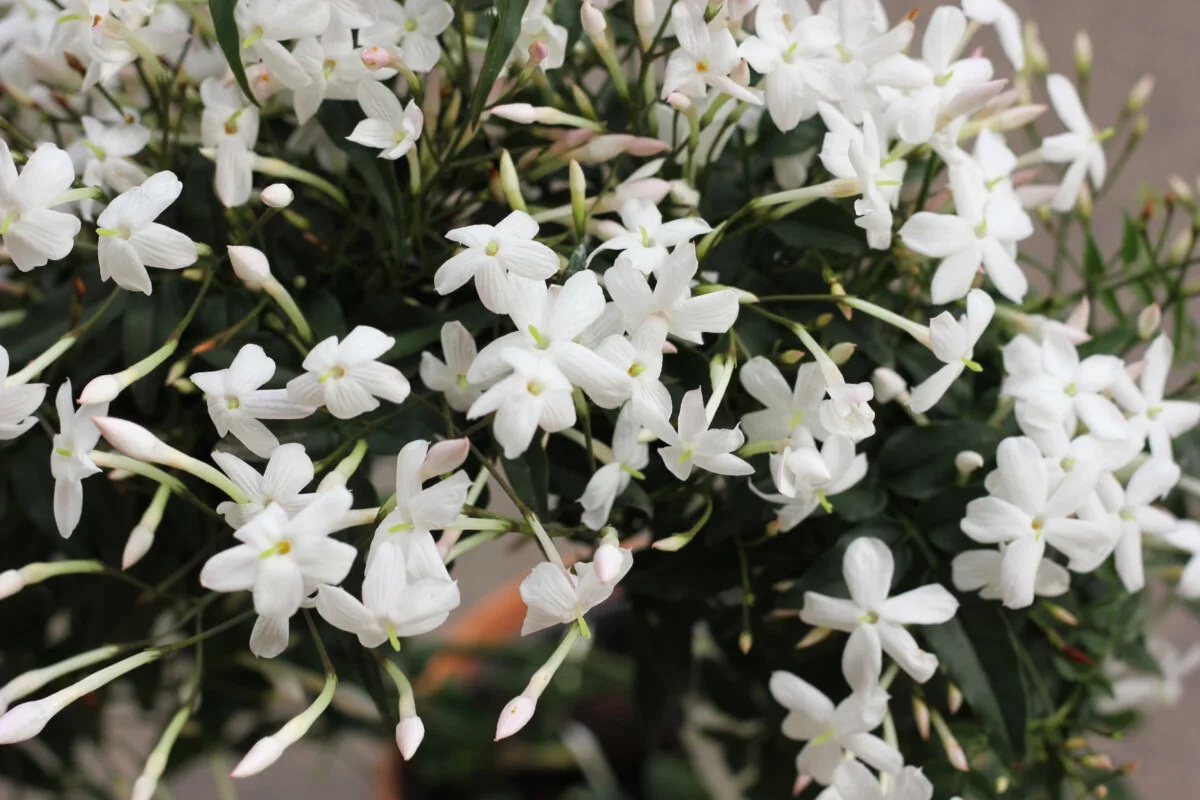
Pink jasmine is one of the more popular jasmine houseplants due to its easy care, low upkeep, and reliable blooming schedule. The flowers, white with a light rose exterior, arise in dense clusters when temperatures are cooler – around 65°F (18°C). The perfume is sweet and quite intense – it hits just the right spot when you’re looking for a feel of spring in the air. All pink jasmine needs is a sunny but cool windowsill to trigger the seasonal blooms.
It’s a vining plant indigenous to the valleys and forests of mountainous Southwest China, where it climbs up structures or rambles along the ground. Pink jasmine confined to the indoors would appreciate a trellis to grow on. Or, let the flowering vines spill out and dangle from a hanging pot.
- Light: South-facing window that receives direct light
- Soil: Organically rich, well-draining mix
- Bloom set: December to March
7. African Violet (Saintpaulia ionantha)
African violets are one of those rare houseplants that freely flower throughout the year. Treat her right, and she has the potential for near-continuous blooms.
Standard varieties are adorable compact plants with pansy-like flowers in blues, pinks, purples or white. But having been bred and hybridized since 1894, there are now more than 16,000 registered cultivars of African violet.
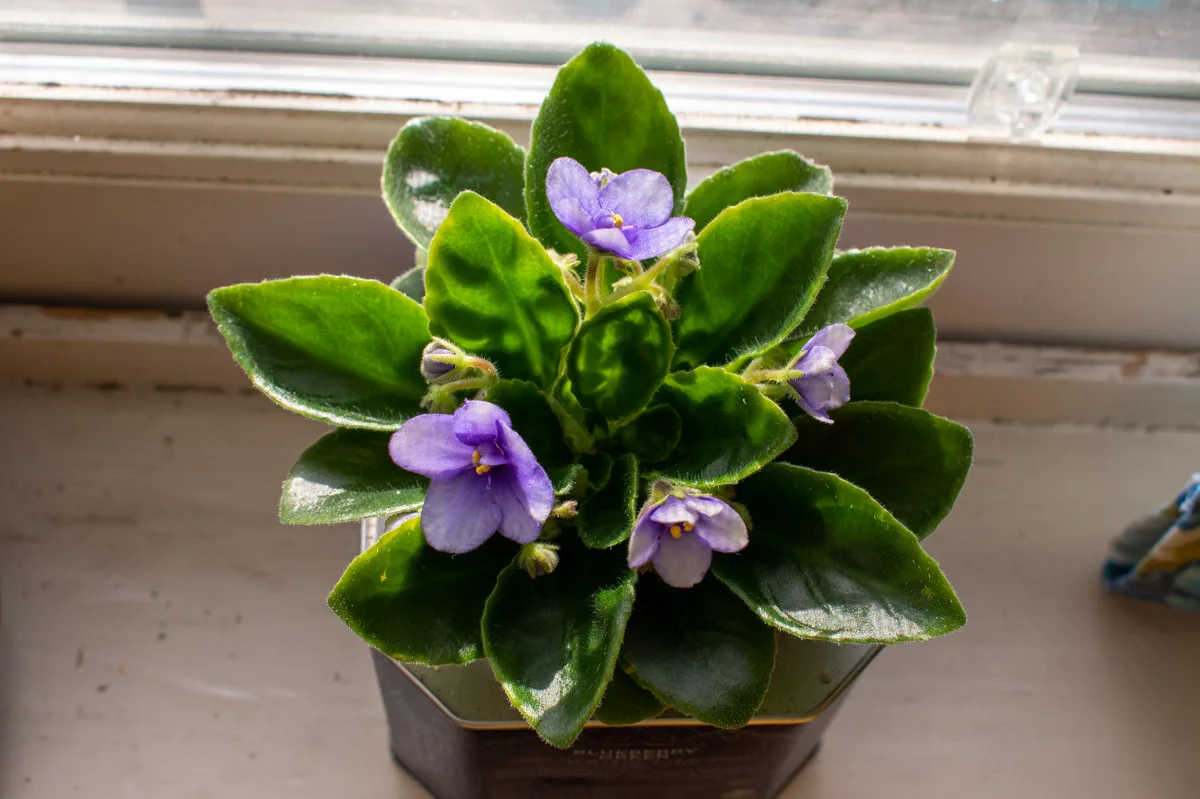
Named Houseplant of the Year for 2024, there’s an unbelievable amount of variety in African violets today. Choose among two-toned, thumbprint, chimera, and speckled edge color markings and flowers that take the shape of stars, bells, or “wasps”. Even the foliage has gotten tweaked, deviating from the usual ovate leaf to scalloped, wavy, or ruffled textures.
Regardless of the cultivar, you can encourage your African violets to flower specifically during wintertime by moving plants to a sunny window or beneath grow lights. Warmth and good light are key for abundant blooms.
- Light: 10 to 12 hours of bright light
- Soil: Well-draining soilless mix
- Bloom set: Flowers freely year-round
8. Lace Flower (Alsobia dianthiflora)
Cousin to African violet, lace flower belongs to the Gesneriaceae family and requires the same culture to induce blooms: warmth and loads of bright light.
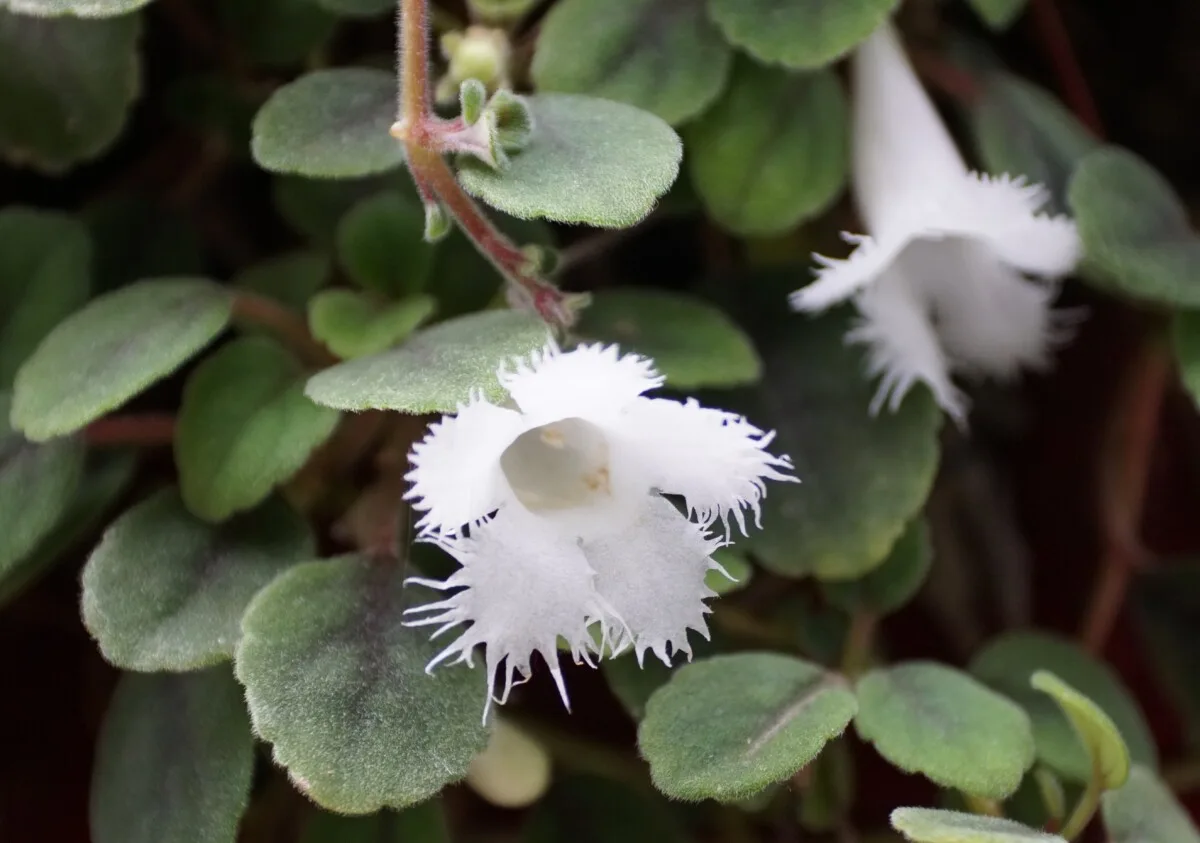
When happy, the lace flower blooms continuously with white, deep-throated flowers roughly one inch across. The plant is aptly named, as each 5-petal flower features a lacy, frilly fringe around the edges. The intriguing flowers emerge from a mat of fleshy, round, furry leaves.
Lace flower is a low-growing ground cover that sprawls along the jungle and forest understory in Mexico, Guatemala, and Costa Rica. Like a strawberry plant, it sends out runners that bear little plantlets, rooting wherever they touch the soil. In the home, lace flower’s trailing habit is best displayed in a hanging planter or swept along a mantle.
- Light: 10 to 12 hours of bright light
- Soil: Organically rich, well-draining mix
- Bloom set: Flowers freely year-round
9. Anthurium (Anthurium andraeanum)
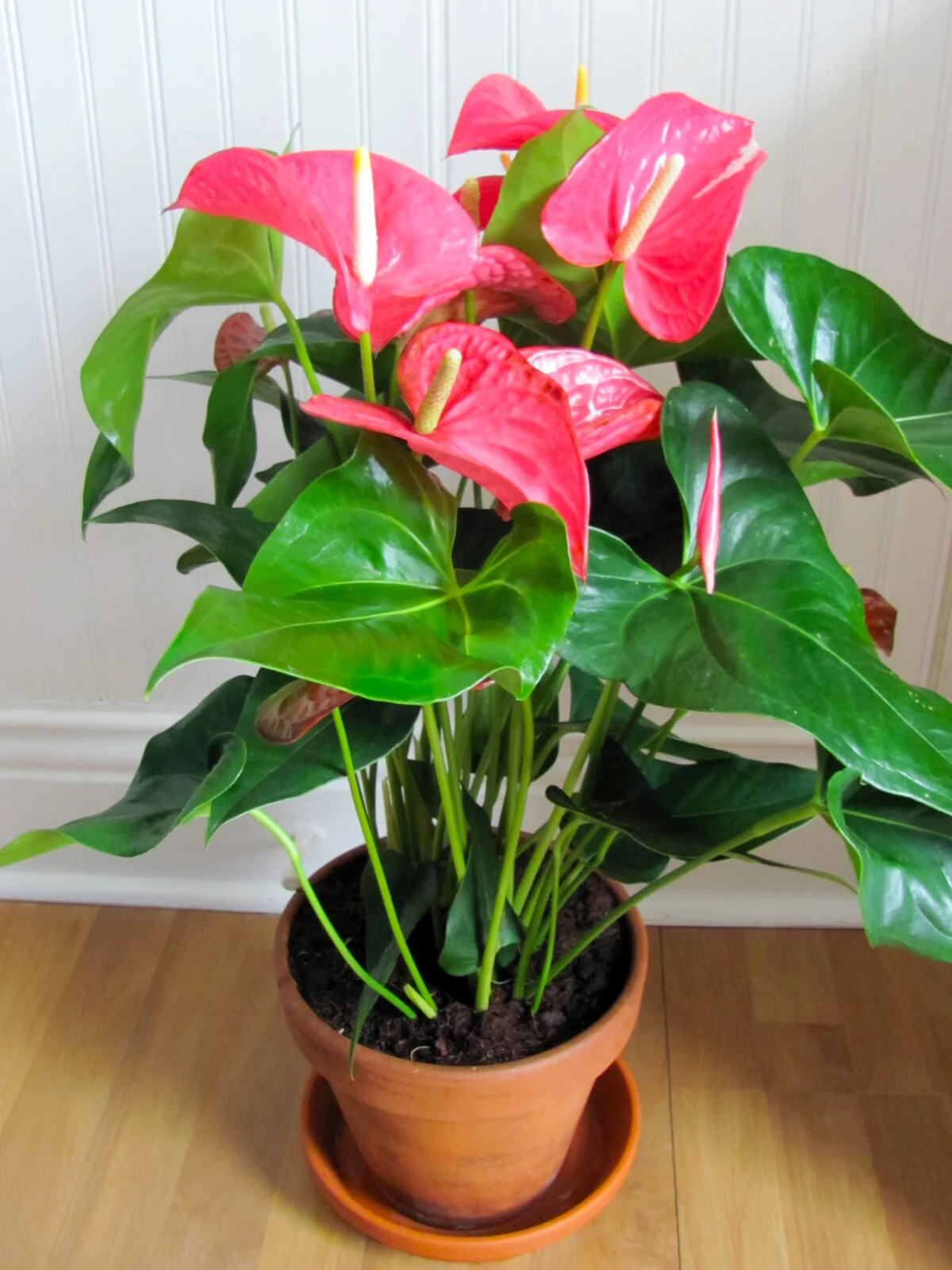
Of the 1,000 species of Anthurium, andreaeanum and its numerous hybrids are more forgiving than most. Also known as flamingo flower – or simply anthurium – the plant is a good one for adding a shock of color to counter the dull wintry days.
The large, waxy, shiny spathes – typically in bright pink or red – wrap around a prominent yellow spadix. When anthurium flowers, individual blooms will last for weeks or months at a time. The flowers emerge, 16 inches tall, from a cluster of upright leaves shaped like elephant ears.
Anthurium needs high light to bloom repeatedly. It’s a delicate balance between plentiful sunlight, but not so much as to scorch the foliage. In winter, a south-facing window or supplementing with grow lights will help spur on flowers. As will monthly feedings of high-phosphorus fertilizer.
In its native habitat, anthurium grows in the tropical rainforests of Colombia and Ecuador, so it enjoys high humidity and a moist environment. Keep the soil moist but not wet, and never allow it to dry completely between waterings.
- Light: Bright direct light in winter; bright indirect light in summer
- Soil: Organically rich, well-draining mix
- Bloom set: Flowers freely year-round
10. Purple Shamrock (Oxalis triangularis)
If you wish to be not so fiddly and exacting with your houseplant care – but still want to drink in all the beautiful colors in winter– then purple shamrock might be the one for you.
An easygoing plant, the foliage of purple shamrock is always vibrant. It generously flowers from fall until spring. And it’s a plant alive with movement as it reacts to light.
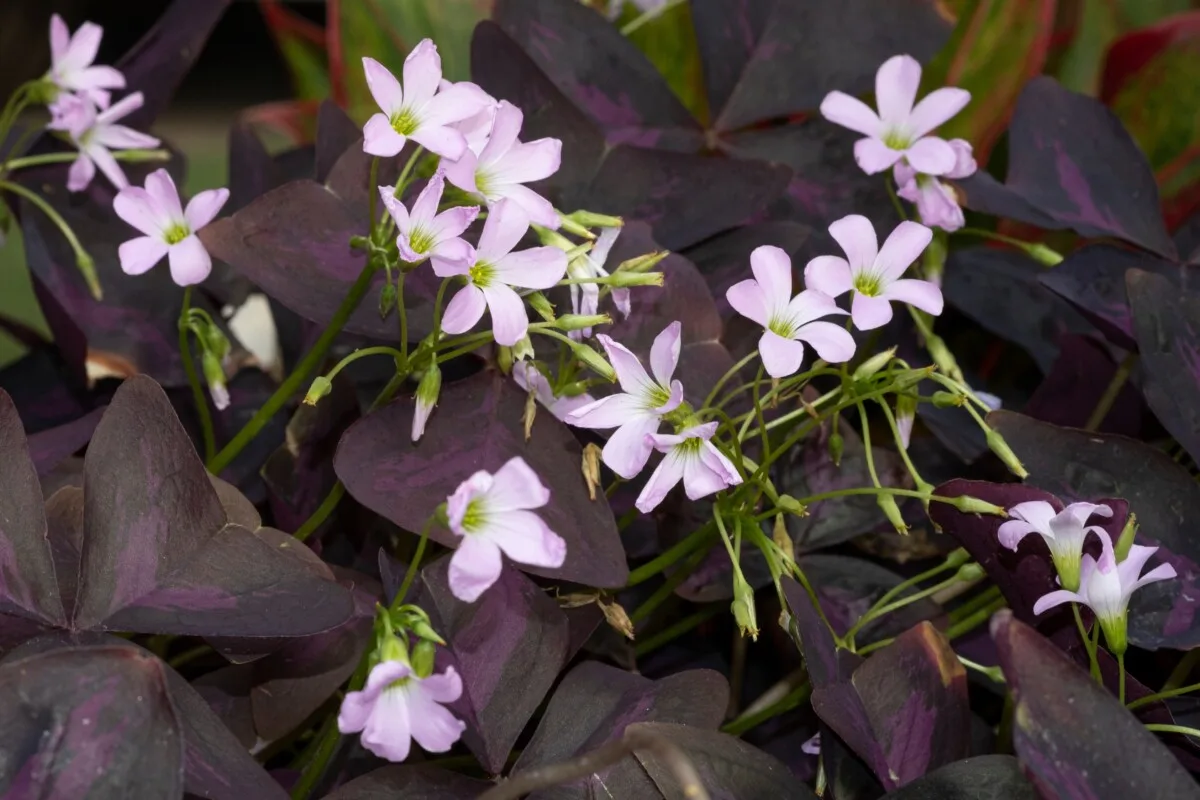
Sprouting from the tuberous rhizomes, purple shamrock shoots bear a trio of triangular leaflets, arranged and angled in such a way they look like butterflies. And they do flutter, opening up their winged leaves during the day and folding themselves up neatly at night.
Cultivars of purple shamrock offer several shades of purple, from maroon, grape, dark magenta, and violet-red, in solid or duotone coloring. The dainty flowers, each less than an inch across, are pink or white and contrast nicely against the foliage.
Purple shamrock grows naturally in tropical rainforests of South America, where it is showiest in winter when temperatures are cooler. As the heat rises above 80°F (27°C) consistently in summer, plants tend to enter dormancy. If your purple shamrock dies back, all you need to do is remove the wilted foliage and water sparingly. It will rebound with fresh growth in about 6 to 8 weeks.
- Light: Bright direct sunlight at least part of the day
- Soil: Organically rich, well-draining mix
- Bloom set: November to March
Winter-blooming houseplants require special care compared with your standard indoor greenery, but the extra steps are absolutely worth it for their captivating colors and shapes.
Getting to know all about the plant’s lighting needs, photoperiods, chilling, and dormancy is the secret for a reliable wintertime blooming schedule. And that’s an excellent plant-based activity to help pass the time!
It’s fair to say that gardeners will be happiest around plants. So once you’ve got a blooming interior, be sure to plant up some winter bloomers to colorize the outdoors too.

Get the famous Rural Sprout newsletter delivered to your inbox.
Including Sunday ramblings from our editor, Tracey, as well as “What’s Up Wednesday” our roundup of what’s in season and new article updates and alerts.

